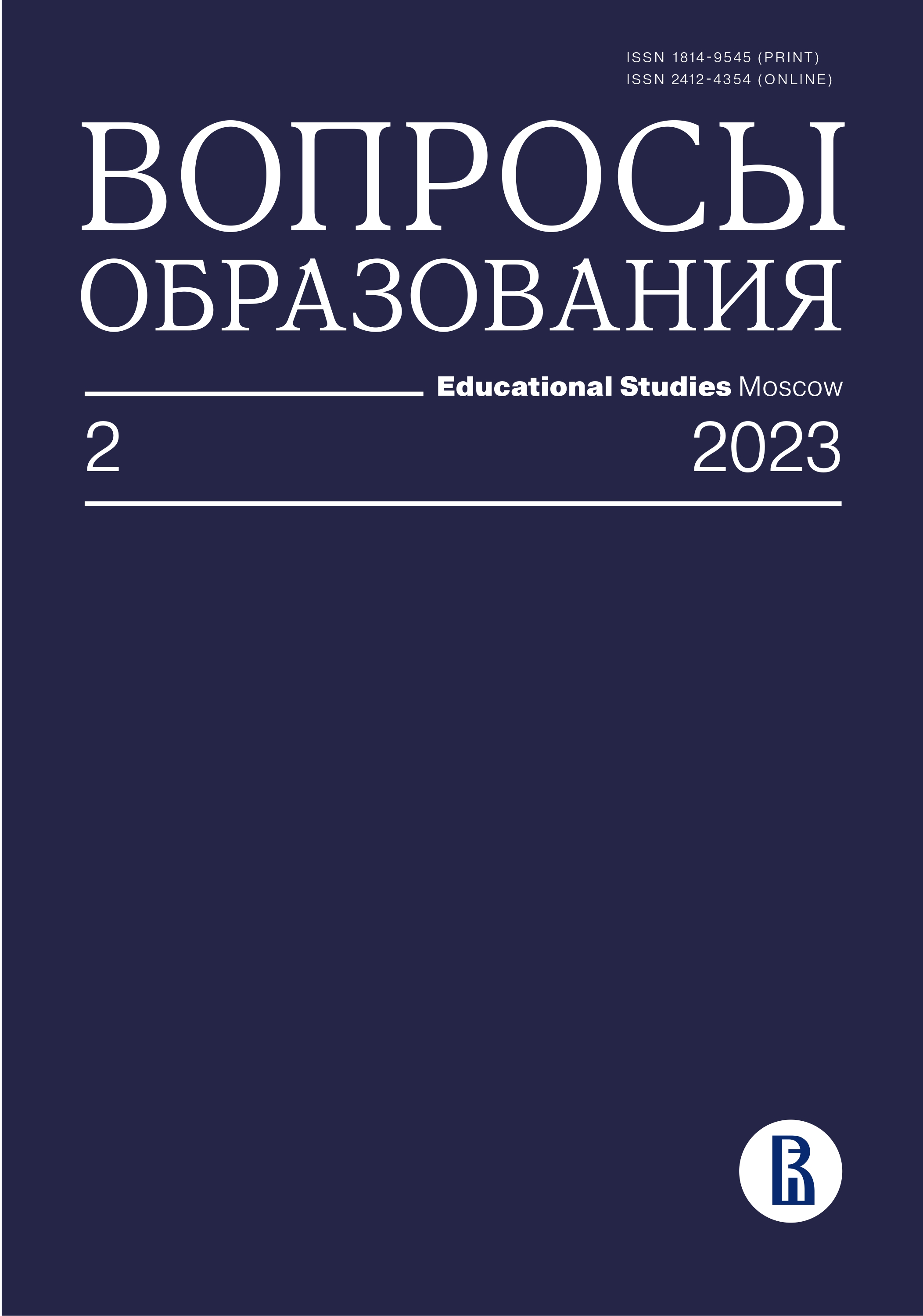Политика NPM в высшем образовании: обзор влияния «нового государственного управления» на эффективность и производительность вузов
Аннотация
Распространение концепции нового государственного управления (new public management) повлекло за собой рост количества исследований результатов применения тех или иных мер государственной политики и оценки эффективности в высшем образовании. В статье представлен систематический обзор эмпирических исследований эффектов государственной политики, на основании которых имеется возможность судить о том, способна ли политика, направленная на повышение результативности, трансформировать и модернизировать деятельность вузов, увеличивая их эффективность и производительность. Механизмы реализации государственных интервенций подразделяются на три вида: это государственная политика в сфере финансирования, реструктуризации и управления автономией. В результате обобщения фрагментарных данных о влиянии государственных интервенций на эффективность и производительность университетов, полученных с помощью оболочечного анализа данных и метода стохастической границы, сформулирован ряд выводов. Создание более конкурентной среды и расширение автономии университетов коррелируют с более высокими показателями эффективности и производительности. Концентрация ресурсов на стороне предложения высшего образования с помощью инициатив превосходства и реструктуризация институционального ландшафта в результате Болонского процесса также показали свою эффективность в трансформации производственной функции университетов. Данные о слияниях вузов, инициированных государством, крайне ограниченны, и польза от реализации этой меры, в отличие от проведения добровольного слияния, вызывает сомнения.
Скачивания
Литература
Abbott M., Doucouliagos C. (2000) Amalgamations and the Efficiency of Queensland TAFE Institutes. Australian and New Zealand Journal of Vocational Education Research, vol. 8, no 2, pp. 1–19. https://search.informit.org/doi/10.3316/ielapa.200108756
Agasisti T., Abalmasova E., Shibanova E., Egorov A. (2022) The Causal Impact of Performance-Based Funding on University Performance: Quasi-Experimental Evidence from a Policy in Russian Higher Education. Oxford Economic Papers, vol. 74, no 4, pp. 1021–1044. https://doi.org/10.1093/oep/gpab039
Agasisti T., Barra C., Zotti R. (2016) Evaluating the Efficiency of Italian Public Universities (2008–2011) in Presence of (Unobserved) Heterogeneity. Socio-Economic Planning Sciences, vol. 55, pp. 47–58. https://doi.org/10.1016/j.seps.2016.06.002
Agasisti T., Bolli T. (2013) The Impact of the Bologna Reform on the Productivity of Swiss Universities. Higher Education Quarterly, vol. 67, no 4, pp. 374–397. https://doi.org/10.1111/hequ.12023
Agasisti T., Catalano G. (2006) Governance Models of University Systems—towards Quasi‐Markets? Tendencies and Perspectives: A European Comparison. Journal of Higher Education Policy and Management, vol. 28, no 3, pp. 245–262. https://doi.org/10.1080/13600800600980056
Agasisti T., Dal Bianco A. (2009) Reforming the University Sector: Effects on Teaching Efficiency—Evidence from Italy. Higher Education, vol. 57, no 4, pp. 477–498. https://doi.org/10.1007/s10734-008-9157-x
Agasisti T., Egorov A., Maximova M. (2021) Do Merger Policies Increase Universities’ Efficiency? Evidence from a Fuzzy Regression Discontinuity Design. Applied Economics, vol. 53, no 2, pp. 185–204. https://doi.org/10.1080/00036846.2020.1803488
Agasisti T., Haelermans C. (2016) Comparing Efficiency of Public Universities among European Countries: Different Incentives Lead to Different Performances. Higher Education Quarterly, vol. 70, no 1, pp. 81–104. https://doi.org/10.1111/hequ.12066
Agasisti T., Shibanova E. (2022) Actual Autonomy, Efficiency and Performance of Universities: Insights from the Russian Case. International Journal of Public Administration, vol. 45, no 2, pp. 121–134. https://doi.org/10.1080/01900692.2021.1903496
Agasisti T., Shibanova E., Platonova D., Lisyutkin M. (2020) The Russian Excellence Initiative for Higher Education: A Nonparametric Evaluation of Short‐Term Results. International Transactions in Operational Research, vol. 27, no 4, pp. 1911–1929. https://doi.org/10.1111/itor.12742
Agasisti T., Wolszczak-Derlacz J. (2015) Exploring Efficiency Differentials between Italian and Polish Universities, 2001–11. Science and Public Policy, vol. 43, no 1, pp. 128–142. https://doi.org/10.1093/scipol/scv026
Aghion P., Dewatripont M., Hoxby C., Mas-Colell A., Sapir A. (2010) The Governance and Performance of Universities: Evidence from Europe and the US. Economic Policy, vol. 25, no 61, pp. 7–59. https://doi.org/10.1111/j.1468-0327.2009.00238.x
Aigner D., Lovell C.K., Schmidt P. (1977) Formulation and Estimation of Stochastic Frontier Production Function Models. Journal of Econometrics, vol. 6, no 1, pp. 21–37. https://doi.org/10.1016/0304-4076(77)90052-5
Arjomandi A., Salleh M.I., Mohammadzadeh A. (2015) Measuring Productivity Change in Higher Education: An Application of Hicks–Moorsteen Total Factor Productivity Index to Malaysian Public Universities. Journal of the Asia Pacific Economy, vol. 20, no 4, pp. 630–643. https://doi.org/10.1080/13547860.2015.1045323
Berbegal-Mirabent J. (2018) The Influence of Regulatory Frameworks on Research and Knowledge Transfer Outputs: An Efficiency Analysis of Spanish Public Universities. Journal of Engineering and Technology Management, vol. 47, pp. 68–80. https://doi.org/10.1016/j.jengtecman.2018.01.003
Bolli T., Olivares M., Bonaccorsi A., Daraio C., Aracil A.G., Lepori B. (2016) The Differential Effects of Competitive Funding on the Production Frontier and the Efficiency of Universities. Economics of Education Review, vol. 52, no 1, pp. 91–104. https://doi.org/10.1016/j.econedurev.2016.01.007
Cai Y., Pinheiro R., Geschwind L., Aarrevaara T. (2016) Towards a Novel Conceptual Framework for Understanding Mergers in Higher Education. European Journal of Higher Education, vol. 6, no 1, pp. 7–24. https://doi.org/10.1080/21568235.2015.1099457
Chandran V.G.R., Nourani M., Selvarajan S.K., Baskaran A. (2020) Selective Research Funding Policy and Catching Up the Ladder in University Research Performance in Malaysia. Managerial and Decision Economics, vol. 42, no 3, pp. 539–550. https://doi.org/10.1002/mde.3252
Charnes A., Cooper W.W., Rhodes E. (1978) Measuring the Efficiency of Decision Making Units. European Journal of Operational Research, vol. 2, no 6, pp. 429–444. https://doi.org/10.1016/0377-2217(78)90138-8
Christensen T. (2011) University Governance Reforms: Potential Problems of More Autonomy? Higher Education, vol. 62, no 4, pp. 503–517. https://doi.org/10.1007/s10734-010-9401-z
Civera A., Lehmann E.E., Paleari S., Stockinger S.A. (2020) Higher Education Policy: Why Hope for Quality When Rewarding Quantity? Research Policy, vol. 49, no 8, Article no 104083. https://doi.org/10.1016/j.respol.2020.104083
Cremonini L., Westerheijden D.F., Benneworth P., Dauncey H. (2014) In the Shadow of Celebrity? World-Class University Policies and Public Value in Higher Education. Higher Education Policy, vol. 27, no 3, pp. 341–361. https://doi.org/10.1057/hep.2013.33
De Groot H., McMahon W.W., Volkwein J.F. (1991) The Cost Structure of American Research Universities. The Review of Economics and Statistics, vol. 73, no 3, pp. 424–431. https://doi.org/10.2307/2109566
De la Torre E.M., Gómez-Sancho J.M., Perez-Esparrells C. (2017) Comparing University Performance by Legal Status: A Malmquist-type Index Approach for the Case of the Spanish Higher Education System. Tertiary Education and Management, vol. 23, no 3, pp. 206–221. https://doi.org/10.1080/13583883.2017.1296966
De Witte K.D., López-Torres L. (2017) Efficiency in Education: A Review of Literature and a Way Forward. Journal of the Operational Research Society, vol. 68, no 4, pp. 339–363. https://doi.org/10.1057/jors.2015.92
Epstein E.H. (1988) The Problematic Meaning of ‘Comparison’ in Comparative Education. Theories and Methods in Comparative Education (eds J. Schriewer, B. Holmes), Frankfurt am Main: Peter Lang, pp. 3–23.
Färe R., Grosskopf S., Norris M., Zhang Z. (1994) Productivity Growth, Technical Progress, and Efficiency Change in Industrialized Countries. The American Economic Review, vol. 81, no 1, pp. 66–83. http://www.jstor.org/stable/2117971
Ferlie E., Musselin C., Andresani G. (2008) The Steering of Higher Education Systems: A Public Management Perspective. Higher Education, vol. 56, no 3, pp. 325–348. https://doi.org/10.1007/s10734-008-9125-5
Flegg A.T., Allen D.O., Field K., Thurlow T.W. (2004) Measuring the Efficiency of British Universities: A Multi‐Period Data Envelopment Analysis. Education Economics, vol. 12, no 3, pp. 231–249. https://doi.org/10.1080/0904529042000258590
Froumin I., Lisyutkin M. (2015) Excellence-Driven Policies and Initiatives in the Context of Bologna Process: Rationale, Design, Implementation and Outcomes. The European Higher Education Area: Between Critical Reflections and Future Policies (eds A. Curaj, L. Matei, R. Pricopie, J. Salmi, P. Scott), Cham: Springer, pp. 249–265. https://doi.org/10.1007/978-3-319-20877-0
Glass J.C., McCallion G., McKillop D.G., Rasaratnam S., Stringer K.S. (2006) Implications of Variant Efficiency Measures for Policy Evaluations in UK Higher Education. Socio-economic Planning Sciences, vol. 40, no 2, pp. 119–142. https://doi.org/10.1016/j.seps.2004.10.004
Glass J.C., McKillop D.G., O'Rourke G. (1998) A Cost Indirect Evaluation of Productivity Change in UK Universities. Journal of Productivity Analysis, vol. 10, no 2, pp. 153–175. https://doi.org/10.1023/A:1018607223276
Guccio C., Martorana M.F., Monaco L. (2016) Evaluating the Impact of the Bologna Process on the Efficiency Convergence of Italian Universities: A Non-Parametric Frontier Approach. Journal of Productivity Analysis, vol. 45, no 3, pp. 275–298. https://doi.org/10.1007/s11123-015-0459-6
Gunter H.M., Grimaldi E., Hall D., Serpieri R. (2016) New Public Management and the Reform of Education: European Lessons for Policy and Practice. New York, NY: Routledge.
Harman G., Harman K. (2003) Institutional Mergers in Higher Education: Lessons from International Experience. Tertiary Education & Management, vol. 9, no 1, pp. 29–44. https://doi.org/10.1080/13583883.2003.9967091
Hopkins D.S. (1990) The Higher Education Production Function: Theoretical Foundations and Empirical Findings. The Economics of American Universities. Management, Operations, and Fiscal Environment (eds S.A. Hoenack, E.L. Collins), Albany, NY: State University of New York, pp. 11–32.
Horta H., Huisman J., Heitor M. (2008) Does Competitive Research Funding Encourage Diversity in Higher Education? Science and Public Policy, vol. 35, no 3, pp. 146–158. https://doi.org/10.3152/030234208X299044
Huisman J. (2019) The Bologna Process in European and Post-Soviet Higher Education: Institutional Legacies and Policy Adoption. Innovation: The European Journal of Social Science Research, vol. 32, no 4, pp. 465–480. https://doi.org/10.1080/13511610.2019.1597686
Jiang J., Lee S.K., Rah M.J. (2020) Assessing the Research Efficiency of Chinese Higher Education Institutions by Data Envelopment Analysis. Asia Pacific Education Review, vol. 21, no 1, pp. 423–440. https://doi.org/10.1007/s12564-020-09634-0
Johnes J. (2006) Data Envelopment Analysis and Its Application to the Measurement of Efficiency in Higher Education. Economics of Education Review, vol. 25, no 3, pp. 273–288. https://doi.org/10.1016/j.econedurev.2005.02.005
Johnes J., Tsionas M.G. (2019) Dynamics of Inefficiency and Merger in English Higher Education from 1996/97 to 2008/9: A Comparison of Pre‐Merging, Post‐Merging and Non‐Merging Universities using Bayesian Methods. The Manchester School, vol. 87, no 3, pp. 297–323. https://doi.org/10.1111/manc.12262
Jongbloed B., Vossensteyn H. (2016) University Funding and Student Funding: International Comparisons. Oxford Review of Economic Policy, vol. 32, no 4, pp. 576–595. https://doi.org/10.1093/oxrep/grw029
Kang Y., Liu R. (2021) Does the Merger of Universities Promote Their Scientific Research Performance? Evidence from China. Research Policy, vol. 50, no 1, Article no 104098. https://doi.org/10.1016/j.respol.2020.104098
Kantabutra S., Tang J. (2010) Efficiency Analysis of Public Universities in Thailand. Tertiary Education and Management, vol. 16, no 1, pp. 15–33. https://doi.org/10.1080/13583881003629798
Kempkes G., Pohl C. (2008) Do Institutions Matter for University Cost Efficiency? Evidence from Germany. CESifo Economic Studies, vol. 54, no 2, pp. 177–203. https://doi.org/10.1093/cesifo/ifn009
Klemenčič M. (2019) 20 Years of the Bologna Process in a Global Setting: The External Dimension of the Bologna Process Revisited. European Journal of Higher Education, vol. 9, no 1, pp. 2–6. https://doi.org/10.1080/21568235.2019.1570670
Kroher M., Leuze K., Thomsen S.L., Trunzer J. (2021) Did the" Bologna Process" Achieve Its Goals? 20 Years of Empirical Evidence on Student Enrolment, Study Success and Labour Market Outcomes. IZA Discussion Papers no 14757. Bonn: Institute of Labor Economics.
Kuo J.S., Ho Y.C. (2008) The Cost Efficiency Impact of the University Operation Fund on Public Universities in Taiwan. Economics of Education Review, vol. 27, no 5, pp. 603–612. https://doi.org/10.1016/j.econedurev.2007.06.003
Lehmann E.E., Meoli M., Paleari S., Stockinger S.A. (2018) Approaching Effects of the Economic Crisis on University Efficiency: A Comparative Study of Germany and Italy. Eurasian Business Review, vol. 8, no 1, pp. 37–54. https://doi.org/10.1007/s40821-017-0091-7
Lepori B., Usher J., Montauti M. (2013) Budgetary Allocation and Organizational Characteristics of Higher Education Institutions: A Review of Existing Studies and a Framework for Future Research. Higher Education, vol. 65, no 1, pp. 59–78. https://doi.org/10.1007/s10734-012-9581-9
Lloyd P.J., Morgan M.H., Williams R.A. (1993) Amalgamations of Universities: Are There Economics of Scale or Scope? Applied Economics, 25, no 8, pp. 1081–1092. https://doi.org/10.1080/00036849300000088
Mergoni A., De Witte K. (2022) Policy Evaluation and Efficiency: A Systematic Literature Review. International Transactions in Operational Research, vol. 29, no 3, pp. 1337–1359. https://doi.org/10.1111/itor.13012
Miller B.A. (2016) Assessing Organizational Performance in Higher Education. San Francisco, CA: John Wiley & Sons.
Moradi-Motlagh A., Jubb C., Houghton K. (2016) Productivity Analysis of Australian Universities. Pacific Accounting Review, vol. 28, no 4, pp. 386–400. https://doi.org/10.1108/PAR-02-2016-0027
Ortagus J.C., Kelchen R., Rosinger K., Voorhees N. (2020) Performance-Based Funding in American Higher Education: A Systematic Synthesis of the Intended and Unintended Consequences. Educational Evaluation and Policy Analysis, vol. 42, no 4, pp. 520–550. https://doi.org/10.3102/01623737209531
Papadimitriou M., Johnes J. (2019) Does Merging Improve Efficiency? A Study of English Universities. Studies in Higher Education, vol. 44, no 8, pp. 1454–1474. https://doi.org/10.1080/03075079.2018.1450851
Paré G., Trudel M.C., Jaana M., Kitsiou S. (2015) Synthesizing Information Systems Knowledge: A Typology of Literature Reviews. Information & Management, vol. 52, no 2, pp. 183–199. https://doi.org/10.1016/j.im.2014.08.008
Quiroga-Martínez F., Fernández-Vázquez E., Alberto C.L. (2018) Efficiency in Public Higher Education on Argentina 2004–2013: Institutional Decisions and University-Specific Effects. Latin American Economic Review, vol.27, no 1, pp. 1–18. https://doi.org/10.1186/s40503-018-0062-0
Rocha V., Teixeira P. N., Biscaia R. (2019) Mergers in European Higher Education: Financial Issues and Multiple Rationales. Higher Education Policy, vol. 32, no 2, pp. 185–202. https://doi.org/10.1057/s41307-017-0076-2
Sav G.T. (2017) Efficiency Evaluations of US Public Higher Education and Effects of State Funding and Pell Grants: Panel Data Estimates Using Two Stage Data Envelopment Analysis, 2004–2013 Academic Years. Journal of Education Finance, vol. 42, no 4, pp. 357–385. https://www.jstor.org/stable/45093640
Sav G.T. (2016) Declining State Funding and Efficiency Effects on Public Higher Education: Government Really Does Matter. International Advances in Economic Research, vol. 22, no 4, pp. 397–408. https://doi.org/10.1007/s11294-016-9602-z
Schubert T. (2009) Empirical Observations on New Public Management to Increase Efficiency in Public Research—Boon or Bane? Research Policy, vol. 38, no 8, pp. 1225–1234. https://doi.org/10.1016/j.respol.2009.06.007
Schubert T., Yang G. (2016) Institutional Change and the Optimal Size of Universities. Scientometrics, vol. 108, no 3, pp. 1129–1153. https://doi.org/10.1007/s11192-016-2015-1
Thai K.Q., Noguchi M. (2021) Investigating the Technical Efficiency of Japanese National Universities Following Corporatization: A Two-Stage Data Envelopment Analysis Approach. International Journal of Educational Management, vol. 35, no 6, pp. 1297–1311. https://doi.org/10.1108/IJEM-10-2020-0456
Tochkov K., Nenovsky N., Tochkov K. (2012) University Efficiency and Public Funding for Higher Education in Bulgaria. Post-Communist Economies, vol. 24, no 4, pp. 517–534. https://doi.org/10.1080/14631377.2012.729306
Tolofari S. (2005) New Public Management and Education. Policy Futures in Education, vol. 3, no 1, pp. 75–89. https://doi.org/10.2304/pfie.2005.3.1.11
Wolszczak-Derlacz J. (2017) An Evaluation and Explanation of (In) Efficiency in Higher Education Institutions in Europe and the US with the Application of Two-Stage Semi-Parametric DEA. Research Policy, vol. 46, no 9, pp. 1595–1605. https://doi.org/10.1016/j.respol.2017.07.010
Woelert P., Lewis J.M., Le A.T. (2021) Formally Alive yet Practically Complex: An Exploration of Academics’ Perceptions of Their Autonomy as Researchers. Higher Education Policy, vol. 34, no 4, pp. 1049–1068. https://doi.org/10.1057/s41307-020-00190-1
Wynen J., Verhoest K., Ongaro E., van Thiel S. (2014) Innovation-Oriented Culture in the Public Sector: Do Managerial Autonomy and Result Control Lead to Innovation? Public Management Review, vol. 16, no 1, pp. 45–66. https://doi.org/10.1080/14719037.2013.790273
Yaisawarng S., Ng Y.C. (2014) The Impact of Higher Education Reform on Research Performance of Chinese Universities. China Economic Review, vol. 31, December, pp. 94–105. https://doi.org/10.1016/j.chieco.2014.08.006
Yang G.L., Fukuyama H., Song Y.Y. (2018) Measuring the Inefficiency of Chinese Research Universities Based on a Two-Stage Network DEA Model. Journal of Informetrics, vol. 12, no 1, pp. 10–30. https://doi.org/10.1016/j.joi.2017.11.002
Yongmei H., Wenyan L. (2008) Malmquist Index Analysis of the Dynamic Changes in Scientific Research Productivity of Some Chinese Universities before and after Merger. Frontiers of Education in China, vol. 3, no 3, pp. 429–447. https://doi.org/10.1007/s11516-008-0028-0
Zacharewicz T., Lepori B., Reale E., Jonkers K. (2019) Performance-Based Research Funding in EU Member States—a Comparative Assessment. Science and Public Policy, vol. 46, no 1, pp. 105–115. https://doi.org/10.1093/scipol/scy041
Zong X., Zhang W. (2019) Establishing World-Class Universities in China: Deploying a Quasi-Experimental Design to Evaluate the Net Effects of Project 985. Studies in Higher Education, vol. 44, no 3, pp. 417–431. https://doi.org/10.1080/03075079.2017.1368475








